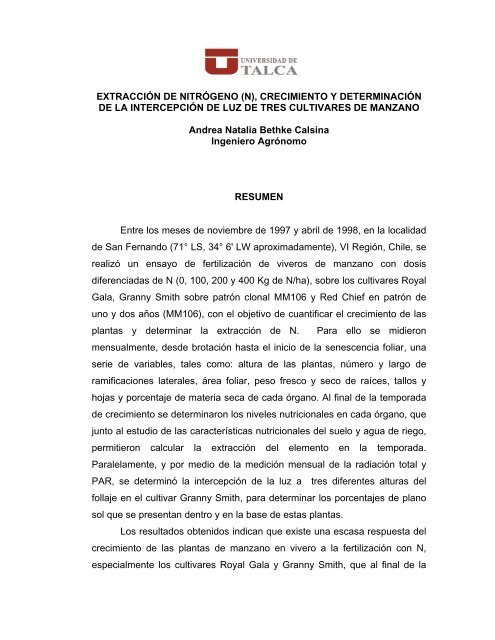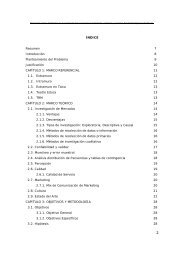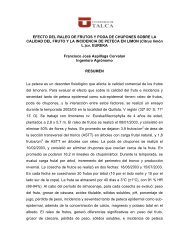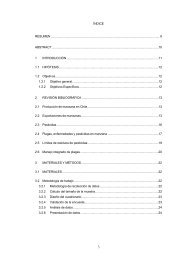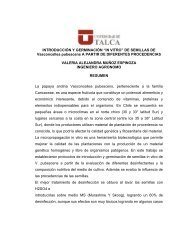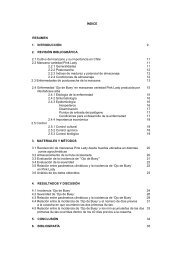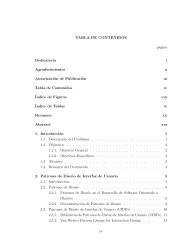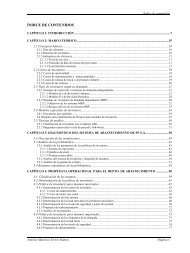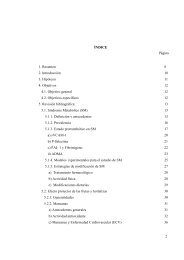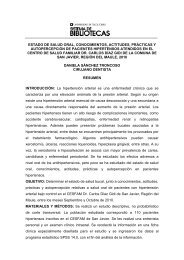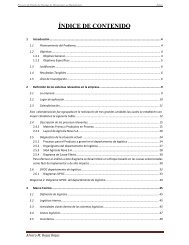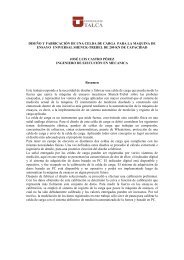extracción de nitrógeno \(n\), crecimiento y determinación de l...
extracción de nitrógeno \(n\), crecimiento y determinación de l...
extracción de nitrógeno \(n\), crecimiento y determinación de l...
You also want an ePaper? Increase the reach of your titles
YUMPU automatically turns print PDFs into web optimized ePapers that Google loves.
EXTRACCIÓN DE NITRÓGENO (N), CRECIMIENTO Y DETERMINACIÓNDE LA INTERCEPCIÓN DE LUZ DE TRES CULTIVARES DE MANZANOAndrea Natalia Bethke CalsinaIngeniero AgrónomoRESUMENEntre los meses <strong>de</strong> noviembre <strong>de</strong> 1997 y abril <strong>de</strong> 1998, en la localidad<strong>de</strong> San Fernando (71° LS, 34° 6' LW aproximadamente), VI Región, Chile, serealizó un ensayo <strong>de</strong> fertilización <strong>de</strong> viveros <strong>de</strong> manzano con dosisdiferenciadas <strong>de</strong> N (0, 100, 200 y 400 Kg <strong>de</strong> N/ha), sobre los cultivares RoyalGala, Granny Smith sobre patrón clonal MM106 y Red Chief en patrón <strong>de</strong>uno y dos años (MM106), con el objetivo <strong>de</strong> cuantificar el <strong>crecimiento</strong> <strong>de</strong> lasplantas y <strong>de</strong>terminar la <strong>extracción</strong> <strong>de</strong> N. Para ello se midieronmensualmente, <strong>de</strong>s<strong>de</strong> brotación hasta el inicio <strong>de</strong> la senescencia foliar, unaserie <strong>de</strong> variables, tales como: altura <strong>de</strong> las plantas, número y largo <strong>de</strong>ramificaciones laterales, área foliar, peso fresco y seco <strong>de</strong> raíces, tallos yhojas y porcentaje <strong>de</strong> materia seca <strong>de</strong> cada órgano. Al final <strong>de</strong> la temporada<strong>de</strong> <strong>crecimiento</strong> se <strong>de</strong>terminaron los niveles nutricionales en cada órgano, quejunto al estudio <strong>de</strong> las características nutricionales <strong>de</strong>l suelo y agua <strong>de</strong> riego,permitieron calcular la <strong>extracción</strong> <strong>de</strong>l elemento en la temporada.Paralelamente, y por medio <strong>de</strong> la medición mensual <strong>de</strong> la radiación total yPAR, se <strong>de</strong>terminó la intercepción <strong>de</strong> la luz a tres diferentes alturas <strong>de</strong>lfollaje en el cultivar Granny Smith, para <strong>de</strong>terminar los porcentajes <strong>de</strong> planosol que se presentan <strong>de</strong>ntro y en la base <strong>de</strong> estas plantas.Los resultados obtenidos indican que existe una escasa respuesta <strong>de</strong>l<strong>crecimiento</strong> <strong>de</strong> las plantas <strong>de</strong> manzano en vivero a la fertilización con N,especialmente los cultivares Royal Gala y Granny Smith, que al final <strong>de</strong> la
temporada presentan características homogéneas, clasificándose <strong>de</strong>ntro <strong>de</strong>las mejores categorías <strong>de</strong> calidad <strong>de</strong> plantas. El cultivar Red Chief sobrepatrón <strong>de</strong> un año mostró una mayor respuesta con la dosis máxima <strong>de</strong>fertilización, sin embargo la calidad <strong>de</strong> las plantas <strong>de</strong> baja a media. Se<strong>de</strong>tectó una mayor <strong>extracción</strong> <strong>de</strong> N con el tratamiento <strong>de</strong> 200 Kg <strong>de</strong> N/hapara Gala y Red Chief en patrón <strong>de</strong> dos años, con 100 Kg <strong>de</strong> N/ha paraGranny Smith y con el testigo para Red Chief sobre patrón <strong>de</strong> un año. Se<strong>de</strong>tectaron diferencias notables entre las cantida<strong>de</strong>s extraídas por losdistintos cultivares (240 Kg <strong>de</strong> N/ha para Granny Smith y 74 Kg <strong>de</strong> N/ha paraRed Chief en patrón <strong>de</strong> un año). Se pudo observar que la cantidad <strong>de</strong>radiación PAR que recibe el interior y la base <strong>de</strong> la planta durante la últimaetapa <strong>de</strong> su <strong>crecimiento</strong>, es muy baja e insuficiente (
ABSTRACTBetween November 1997 and April 1998, in San Fernando's (71° LS,34° 6 ' LW approximately), VI Region, Chile, was carried out some trials ondifferent fertilization rates in apple nursery (0, 100, 200 and 400 Kg of N/ha),on cv Royal Gala, Granny Smith on clonal rootstock MM106 and Red Chief inrootstock of one and two years old (MM106). The objective was quantify plantgrowth and <strong>de</strong>terminate nitrogen (N) extraction. It was measured monthly,from the start to the end of the season, the following parameters: plantsheight, branchering, foliar area, fresh and dry weight, and dry matter of roots,shoots and leaves. At the end of the growing season were <strong>de</strong>terminated thenutritional levels of roots, shoots and leaves. Further more, it was measurednutritional characteristics of the soil and water irrigation, with this data wascalculate the extraction of Nitrogen in the season for each cv.Total and PAR radiation was measured monthly on different heights oncv Granny Smith.All analyzed cultivars had low response to nitrogen fertilization. Galaand Granny Smith cultivars produce the best quality plants according tonursery standards, Red Chief on two years old rootstocks showed differentrank quality, cv Red Chief on one-year old rootstocks lower quality plants.Removal levels of N change between 240 and 74 KgN/ha to cv Granny Smithand Red Chief on one-year-old rootstocks respectively. Gala and GrannySmith had higher response with 200 KgN/ha, Red Chief on one-year-oldrootstocks on test (no N). The radiation percentage measured insi<strong>de</strong> canopyand foliage basement, at the end of the season, was insufficient (


